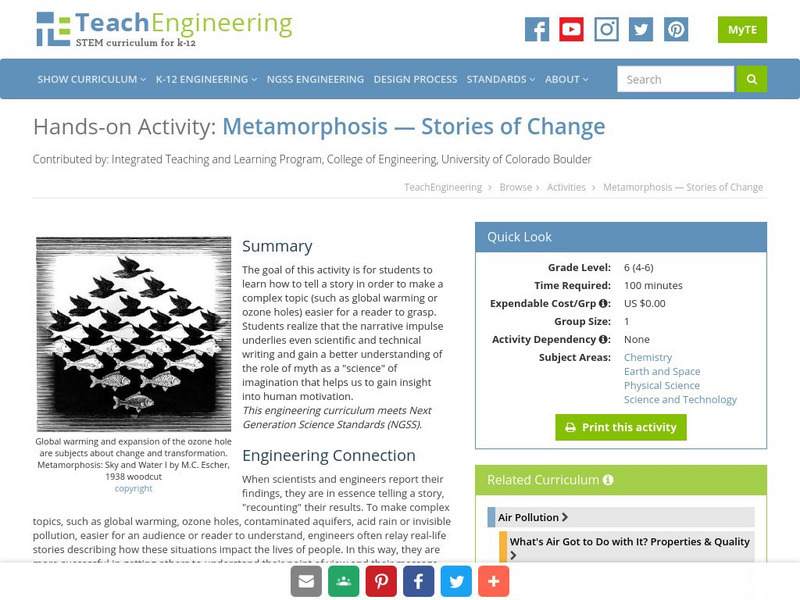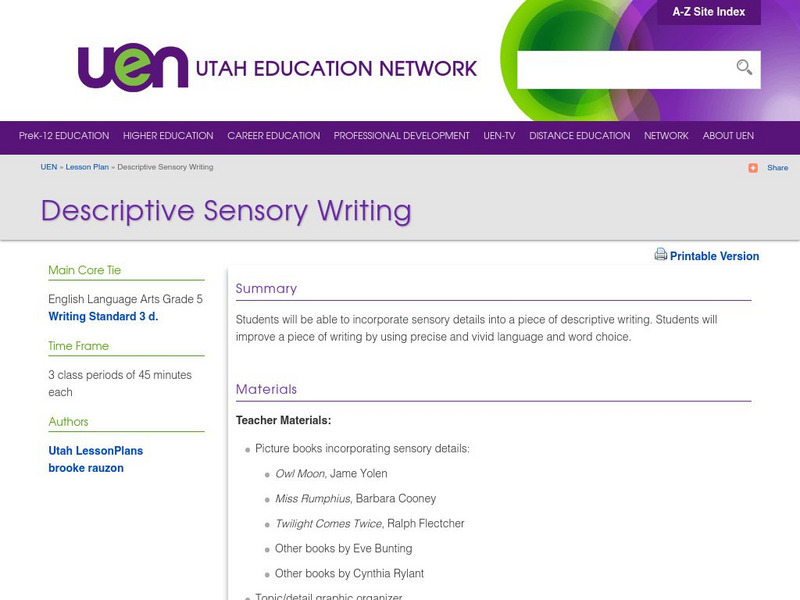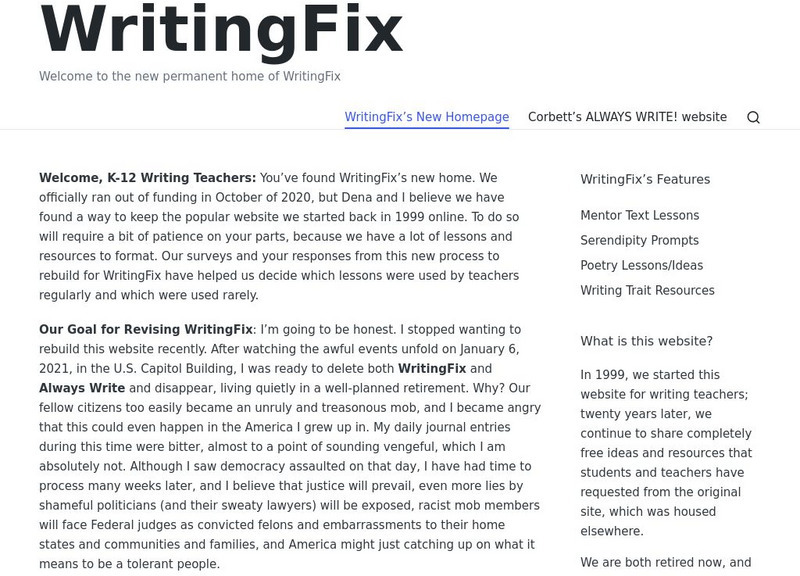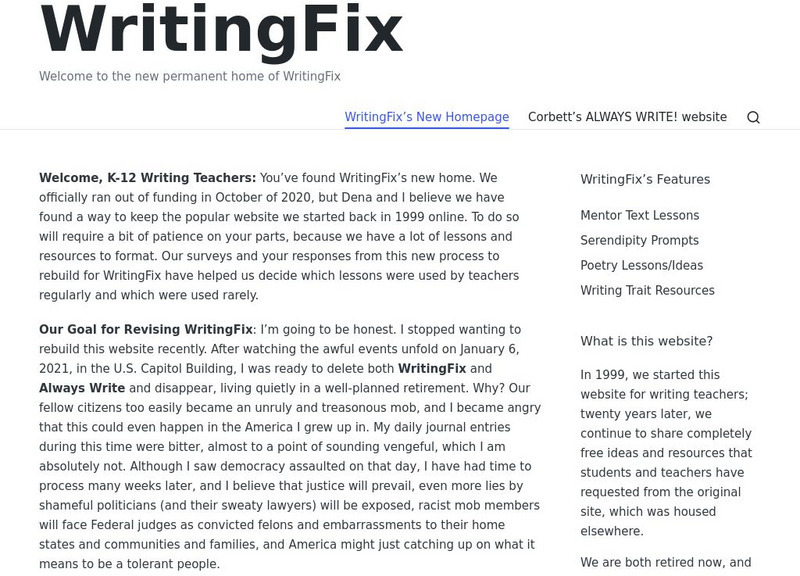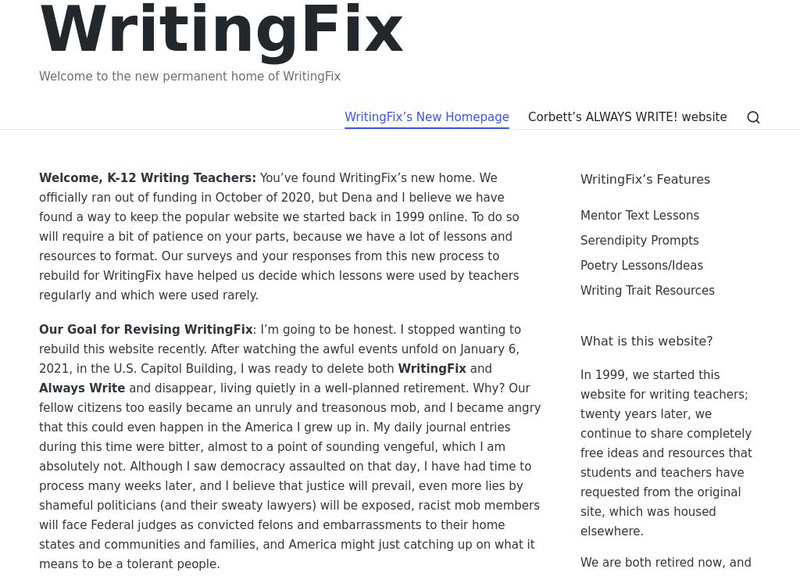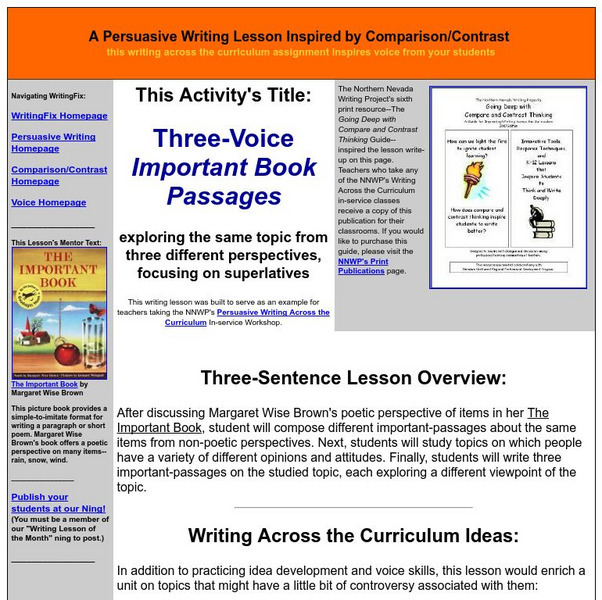TED Talks
Ted: Ted Ed: How to Write Descriptively
The point of fiction is to cast a spell, a momentary illusion that you are living in the world of the story. But how do writers suck readers into stories in this way? Nalo Hopkinson shares some tips for how to use language to make your...
ReadWriteThink
Read Write Think: Exploring Art Through Descriptive Writing
Contains plans for two lessons that use the book "Anna's Art Adventure" by Bjorn Sortland to teach students to write about art descriptively. In addition to objectives and standards, this instructional plan contains links to sites used...
University of South Florida
Fcat Express: Cause and Effect
Site provides extensive assistance in preparing 4th grade students for Florida Comprehensive Assessment Test. This section helps students identify cause and effect in literature.
TeachEngineering
Teach Engineering: Metamorphosis Stories of Change
The goal of this activity is for students to learn how to tell a story in order to make a complex topic (such as global warming or ozone holes) easier for a reader to grasp. Students realize that the narrative impulse underlies even...
Utah Education Network
Uen: Descriptive Sensory Writing
In this lesson, 5th graders will engage in descriptive writing. Students will improve a piece of writing by using precise word choices that are full of sensory word choices.
Annenberg Foundation
Annenberg Learner: Literature: Describing Setting
Short explanation of setting as a literary term. Written in the context of "What makes a good short story?" A link at the bottom of the page leads to additional information about setting.
Utah Education Network
Uen: One True Story, Told Two Ways
Analyze the different perspectives presented by two authors telling the same story.
Reading Rockets
Reading Rockets: Descriptive Writing
This is a comprehensive article about what descriptive writing including what it is, why to teach it and strategies to teach it. It also features two videos Five Senses Graphic Organizer and Writing Poems as well as an annotated list of...
PBS
Pbs Learning Media: In This Together
Students are asked to explain how a crane's parts work together to achieve the end result.
Ted Nellen
Cyber English (By Ted Nellen): Characterization
This is a glossary entry for the term "Characterization" including a definition and the characteristics to be developed: Character's appearance, actions, thoughts, voice, and reaction from others.
Writing Fix
Writing Fix: You're on a Gigantic Roll
In this lesson plan the writer will imagine and compose a descriptive paragraph that focuses on a gigantic object moving through a specific setting and leaving destruction in its wake, modeled after the book James and the Giant Peach by...
Writing Fix
Writing Fix: The Sum of Its Parts
Inspired by Julianna's understanding (from the novel Flipped by Wendelin Van Draanen) that "A painting is more than the sum of its parts," learners will describe a memorable place that evokes a certain feeling or emotion. Students will...
Writing Fix
Writing Fix: Your Own Faraway Place
For this lesson, students will build background by hearing an excerpt from The Phantom Tollbooth by Norton Juster, an excerpt where the main character, Milo, travels to a distant land that has a distinctive mood: melancholy. Next,...
Writing Fix
Writing Fix: Responding to Comparison/contrast: 3 Voice Storyboard: Feeling [Pdf]
In this PDF lesson, students study topics on which people might have differing feelings; they then create three dialogue bubbles that represent three different viewpoints: one that loves the topic, one that dislikes it, and one with a...
Writing Fix
Writing Fix: A Picture Book Writing Lesson: Start With What Isn't There
In this lesson plan, learners will describe a setting, attempting to set a mood for their readers in two paragraphs. Borrowing a technique from Stephen Kramer's two-page introduction to Caves, they will begin with a paragraph that...
Writing Fix
Writing Fix: I Wanna: Writing a Persuasive Letter
In this activity, students will experiment with word choice as it relates to persuasion.
Writing Fix
Writing Fix: Giving Voice to Opposites
In this lesson, students will develop a narrative in opposing voices.
Writing Fix
Writing Fix: Creative Convincing
In this lesson, students will create a friendly letter taking on the persona and voice of a persuasive animal.
Writing Fix
Writing Fix: Three Voice Important Book Passages
A lesson plan made for young scholars to write from various perspectives regarding the same topic. The mentor text entitled The Important Book is used, as students become more familiar with voice, point of view, persuasive techniques and...
Writing Fix
Writing Fix: A Most Nutritious Election
In this lesson young scholars will write a persuasive speech for the Fruit or Vegetable of the Year Award. Nutrition information should be incorporated into this cross-curricular lesson.
Writing Fix
Writing Fix: Inventing Stories for Your Favorite Clothes
After reading several clothing descriptions and stories from the J. Peterman Clothing Catalogue, learners imitate the voice of the catalogue to write descriptions and stories of their own clothes. Teacher instructions, printable graphic...
E Reading Worksheets
E Reading Worksheets: Teaching Point of View
This teaching module provides a way to help students identify the point of view in a text. Essential point of view definitions and worksheets are provided. A multi-slide PowerPoint presentation is included that provides graphic...
Curated OER
Mc Graw Hill: Part 1 Reading: Literature: Describe a Setting
Do you know how to find the setting of a story? Learn how to find the when and where a story took place on this site.
Curated OER
Mc Graw Hill: Part 1 Reading: Literature: Retell Events
Retelling a story shows a student's comprehension. Use this site to test your knowledge of how to retell events that happen in a story.





